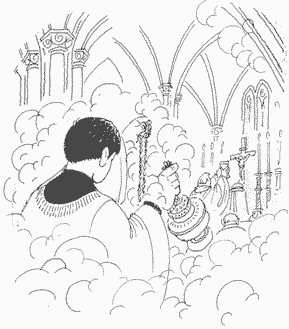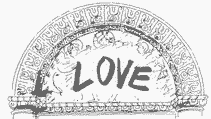The Liturgical Revolution
Text by Michael Davies, Illustrations by John Ryan
|
Our book department often receives requests from readers for a straightforward introduction to the Liturgical Revolution which followed Vatican II, something they can give to friends who are disturbed by the changes in the Mass but have done no reading on the subject. They are looking for something which is documented, but not very technical; and which is balanced but pulls no punches. We asked Michael Davies if he could produce something to fit the bill. He sent us the text of a lecture he delivered at the Holy Rosary Parish Hall, in Portland, Oregon, on 4 August 1982, as part of his Northwest Forum sponsored by Roman Catholic Laity for Truth. It was just what we were looking for, and we have decided to print it almost exactly as he delivered it, making virtually no changes to adapt it from the spoken to the written medium. A few ad lib remarks to the audience have been omitted and we have added references for some of the quotations for the benefit of anyone wishing to follow them up. In order to ensure that the article makes the maximum possible impact we asked John Ryan, one of England's best-known illustrators to read it through and provide us with some drawings. They get to the essence of the Liturgical Revolution as forcefully as Michael Davies' text. One of the most disturbing effects of the ongoing revolution of the past twenty years is that many Catholics are becoming desensitized. They are losing the capacity to be shocked. The dog in the sanctuary, the dancing bishop, the "priest-in-the-box"—these are not just the fantasies of a brilliant cartoonist—they are based in fact, they actually happened, and were reported with approval in the official Catholic press of our country. Extra copies of this issue are available. Please buy them and distribute them to your friends. If they tell you they are shocked, tell them that they ought to be!
|
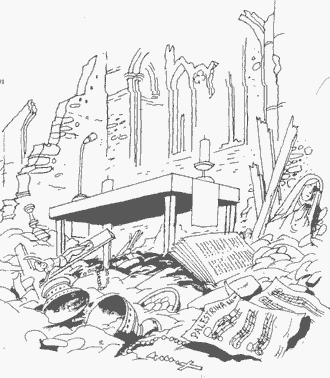
TONIGHT I'll be giving you two readings. The first is short and brilliant and it sums up in the form of an allegory all there is to be said about the liturgical changes which have followed the Second Vatican Council. I didn't write it. I would have liked to, but alas I didn't. The second reading is my own work. It is much longer and it will certainly not be brilliant. What is more, it only repeats and documents what is contained in the first reading.
The short and brilliant allegory which you will hear first was written by an Archbishop who has had a considerable influence upon my thinking about the liturgy. The Archbishop I am speaking of is Archbishop Dwyer of Portland, Oregon, and coming here tonight is for me something in the nature of a pilgrimage. I first began my writing on the subject of Catechetics. I was very much heartened to discover that there was an Archbishop making criticisms of the new Catechetics identical with those I had formulated as a result of my own independent research. As the years passed I grew less and less happy with the changes in the Liturgy, and, lo and behold, I found that Archbishop Dwyer was articulating my own objections yet again.
In 1974 he wrote an allegory entitled "Death of a Cathedral." I shall now read you a slightly abbreviated version.
Death of a Cathedral
We wandered, the other day, through the ruins of a great cathedral. Once, not so long ago, we had known it as a superb structure, one of the supreme glories of the human achievement. It had a style all its own, or you might say it was a uniquely successful amalgam of all styles, the simplicity and severity of the classical, the richness and colour of the Byzantine, the rugged strength of the Romanesque, the soaring lightness of Gothic, the expanse and expensiveness of the baroque. Its architects, many of their names lost to history, had collaborated over the centuries to produce this miracle of diversity in unity, something never achieved, even remotely, elsewhere in the world.
You would enter through its generous portal to find yourself in a narthex that outdid Vezelay in mystery and majesty, then on into the vaulted nave, reassured by a glance down its noble length that you were indeed in the House of the Lord; the lights burned ruby-red before the distant high altar. And everywhere, so it seemed, there were shrines, delicately wrought and enriched by the votive offerings of countless generations of men and women, the great of the earth and the humble, given in token of their faith and devotion. It was said that every saint in the calendar was honored there, either by an altar shrine or by some appropriate memorial, and though we never put the allegation to the test, it seemed to us possible. And in the windows, glorious in their brilliant translucence, were portrayed the mysteries of faith, the life of Our Lord told in loving detail, and the dogmas of religion expressed with all the ingenuity of symbolism. And my immemorial prescription, only orthodox Catholic doctrine was tolerated, no compromises were permitted with revealed and defined truth, no watering down of the common teaching of the Church. The vast multitudes that thronged the fane on Sundays and major feasts, or came on ordinary weekdays to assist at the sacred ceremonies, could listen with profound assurance that what they were hearing was the uncontaminated, undiluted Word of God. The last time we were there, it must have been about 1956, a solemn pontifical Mass was being sung at the High Altar. The sanctuary, spacious and magnificently proportioned, set the stage for the ritual of reverent pageantry, though in its essential lines simplicity itself. Rhythm and grace showed in every practised movement, from the venerable prelate who was the celebrant down to the lowliest acolyte. The ancient Latin chants came forth with haunting sonority and as we looked around at the attentive faces of the immense multitude, not one did we discover who seemed not to understand and appreciate what was being said and done. And then, at the appointed times, the great choir would break forth in thrilling crescendos of polyphony, Palestrina's Missa Papae Marcelli, if memory serves. When the last blessing was given and the Ite Missa Est chanted, we went out into the noonday sunlight with a sense of exhilaration and spiritual uplift which was far removed from any mere emotional spree. We had experienced again what Hilaire Belloc had pronounced the supreme moment of the Christian ages: High Mass in a medieval cathedral. Save for the difference that our cathedral was of all times. Well, we came back to our cathedral the other day, after an absence of almost a decade. We had been forewarned what to expect and so were not wholly unprepared for the shock awaiting us. Even so, the actual sight of the ruin was traumatic. We walked up the broad esplanade leading to its glorious facade, and at a casual glance all seemed normal and as usual. But as we approached, it became painfully evident that the hand of the barbarian and the iconoclast had been at work. Every niche had been emptied of its storied statue, many of them of extreme antiquity, yet in a marvellous state of preservation. The tympanum over the portal, a great bas-relief of Christ in Glory, had been brutally chipped away and the word "love" daubed in blue paint over the vacant space.
The scene was one of utter desolation. Practically every shrine had been violated and destroyed, every carving defaced, every window broken. The great pulpit had been pulled down, and in its place, on a platform of bare boards, stood a microphone, and beside it, reposing on a folding chair, was a guitar case. We looked for the familiar high altar, once a rival of the wonderful reredos of Winchester, but it was gone. A plain deal table stood there, covered by a rather dirty cloth on which candle grease had been spilled. There was no crucifix to identify its purpose. We asked our taciturn companion where the Blessed Sacrament was kept, but he shrugged his shoulders in boredom. Do many come here for Mass these days? we ventured to inquire, and he satisfied himself and us by holding up the fingers of one hand. He may have exaggerated. We went out into the noonday sun this time with an aching heart. No enemy had done this, but the children of the household itself. Oh yes, you wanted to know the name of the cathedral and its location? It is the Cathedral of the Sacred Liturgy, and it is found anywhere in the Catholic world in this year of grace, 1974.
Reverend Fathers, ladies and gentlemen, you do not need me to give you any explanation of the meaning of this allegory. In my opinion no one will ever express more clearly the fact that in the past 15 years we have witnessed the destruction of a liturgical heritage which as Archbishop Dwyer expressed it, "was one of the supreme glories of human achievement, a miracle of diversity in unity, something never achieved even remotely elsewhere in the world." In other words, we have witnessed not a reform but a revolution. I shall share with you some thoughts of my own upon this revolution. I cannot hope to match the elegance and erudition of the great prelate I have been quoting, but I hope you will agree that the comments I make are fair and factual.
Father Frechette of Baltimore
 |
I will begin my discussion of the liturgical revolution in the Diocese of Baltimore. This diocese has an official newspaper entitled The Catholic Review. Its 20 February 1981 edition contained an interesting report on the methods used by a certain Father Frechette to make the celebration of Mass more lively for his parishioners. Two puppets named Noah and Norah were married during Mass, and afterwards a reception was held for them in the parish hall. On Palm Sunday a man on a donkey rode down the aisle; at Christmas, in deference no doubt to the concept of equal opportunities, a lady was given star
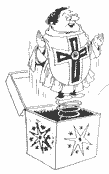 |
billing, and did the same thing mounted upon a pony. Father Frechette's dog sits in the sanctuary and, I quote, "gives his paw during the exchange of peace before communion." On another occasion the congregation watched with bated breath while a large trunk was carried into the sanctuary and left before the altar. What did Father Frechette have in store for them this time? He had developed their critical faculties to the extent that they expected only the highest standard of entertainment. Their mentor fulfilled their expectations. The lid of the trunk flew open and out lept a visiting priest, vested and ready to celebrate the Mass, if indeed what was to take place could be described as a Mass.
Three Definitions
The incidents I have been describing epitomize the revolution which has taken place in the liturgy of the Roman Rite of the Catholic Church. Before continuing I would like to define three terms: "revolution," "liturgy," and "rite."
The Concise Oxford Dictionary defines revolution as a "complete change, turning upside down, great reversal of conditions, fundamental reconstruction."
In his Encyclical Letter Mediator Dei, Pope Pius XII defines liturgy as follows:
The Sacred Liturgy is the public worship which our Redeemer, the Head of the Church, offers to the heavenly Father and which the community of Christ's faithful pays to its Founder, and through Him to the Eternal Father; briefly, it is the whole public worship of the Mystical Body of Jesus Christ, Head and members.
Please note carefully that Pope Pius teaches us that the liturgy is primarily something which Our Lord Jesus Christ does, and with which we have the privilege of associating ourselves. "Liturgy" is derived from a Greek word meaning a public service. A leitourgos was a man who performed a public service for the people. The Epistle to the Hebrews describes Our Lord as the "Leitourgos of holy things." The liturgy is His public religious work, undertaken to glorify His Father and bring grace to His people; it is above all the making present of that supreme sacrifice of Calvary in which He offered atonement for the sins of all mankind and at the same time won grace sufficient to redeem all men.
Our final definition concerns the word "rite." It can mean two things. Firstly, an entire complex of religious services used by a particular group in the worship of God; we can thus speak of Jewish rites, Muslim rites, and Christian rites. Within the Catholic Church there are a number of rites in this sense of the word. The largest, and the one to which we belong, is the Roman Rite. This is the complex of services for the worship of God and administration of the sacraments which developed over the centuries in the diocese of Rome, and which, due to the prestige of the first diocese of Christendom, was adopted by Catholics in many other countries, and was spread throughout the world by its missionaries. A number of religious orders such as the Dominicans have their own rite, but these are usually variants of the Roman Rite. There are also the Catholic Oriental Rites which appear very different from our own. The best known example in the U.S.A. is the Byzantine Rite used by Ukranian Catholics. If anyone hasn't been to one of their Masses I would recommend him to do so at the first opportunity. It may be celebrated in Church Slavonic, modern Ukranian, or even English; in every case you will find it reverent and inspiring.
But, as I have said, we belong to the Roman Rite. When I speak of that rite undergoing a revolution I mean that the complex of services we once knew and loved—Baptism, Confirmation, Ordination, the Mass and Benediction, to cite just a few—has been completely changed, turned upside down, undergone a fundamental reconstruction.
The word "rite" can also be used to refer to a particular religious service within the entire complex; we speak of "the rite of Baptism," "the rite of Confirmation," "the rite of Mass." Where the sacraments are concerned, we must be particularly careful not to confuse the sacramental rite with the sacrament itself. Let us take the Sacrament of the Eucharist as an example. There is only one Sacrament, only one sacrifice, the making present of the Sacrifice of Calvary upon our altars when a validly ordained priest using the correct matter says the words of Consecration with the intention of doing what the Church does. But there are dozens of rites recognized by the Church which make this sacrifice present, and the Sacrifice of the Eucharist is equally that sacrifice, whichever rite is used.
Faith Destroyed
Now I wish to make a very serious allegation. I believe that the liturgical revolution within the Roman Rite of the Catholic Church has not only succeeded in destroying that rite, but in destroying the Catholic faith of many of the faithful who belong to it. The first book of my trilogy, the Liturgical Revolution, entitled Cranmer's Godly Order, is sub-titled "The Destruction of Catholicism through Liturgical Change." Thomas Cranmer, chosen by Henry VIII as his Archbishop of Canterbury, was the principal author of the Anglican Prayer Book. The English people were forced to attend church by law, and when in church they were forced to use a Protestant liturgy; they eventually abandoned their Catholic faith and became Protesants.1 There is a Latin axiom "lex orandi, lex credendi"—"the law of prayer is the law of faith"—in other words, the way men pray reflects what they believe.
Am I exaggerating in my allegation that the way Mass is celebrated in so many churches today has destroyed the faith of large numbers of the faithful? Would to God that I were! Can a priest who will begin Mass by jumping out of a trunk really believe that he will shortly bring the Son of God down upon the altar, that is presuming there is an altar to bring Him down upon? Can members of a congregation who do not walk out in protest at such an outrage believe that they are shortly to have the privilege of participating in the awesome sacrifice of our redemption? Can men and women who shake a little doggie's paw before receiving Holy Communion, no matter how cute that little doggie may be, really believe that they are about to receive the actual Body of Christ? I don't want to be uncharitable, I don't think I'm malicious by nature, but I wonder—I can't help wondering. Archbishop Dwyer of Portland also wondered. In an undelivered letter to Pope Paul VI he wrote:
Communicants flock to the Communion rail in all sorts of attire, from short shorts to near bath suit undress....Near jazz music in rollicking fashion accompanies those approaching the Table of Our Lord....Many children do not genuflect any more. Many adults also fail to genuflect. They roam around church, sit down in their pew without even so much as a nod to recognize Our Lord in the tabernacle. The Real Presence is not emphasized—the supreme holiness of the Blessed Sacrament has been relegated to the background. The bread and wine have been too completely represented as symbols "of the work of men's hands."2

Father Frechette Once More
I have by no means narrated the full story of the sacrilegious antics of Father Frechette of Baltimore. On another Sunday he arranged for a fire drill to take place during Mass, and the fire department attended! What has this got to do with the Holy Sacrifice of the Mass for which the Martyrs of my country died? Would St. Edmund Campion, St. Nicholas Owen, St. Richard Gwynn, or St. Margaret Clitherow have taken part in a Mass during which a fire drill was staged? They would have died first! I tell you they would have died, they would have been torn to pieces rather than be present in a church where it was done. But Father Frechette's people don't feel that way: could anyone say that his congregation has the same faith as the Martyrs of England and Wales? I hope not, I very much hope not.
But we haven't got to the really horrifying part of the story yet, worse is yet to come. The appalling saga of Father Frechette appeared in the official Catholic newspaper of his diocese. It is therefore legitimate to presume that the editors considered it the sort of news that would be read with interest and approval by their average reader—and I believe that their judgment is correct. Furthermore, they must have concluded that it was the sort of news that would be read with approval by the bishop of the diocese—and I believe again that their judgment was correct. Are people who would approve of such antics Catholic—how can they be? Is a bishop who would approve of such antics truly a Catholic Bishop? Of course he isn't!
A "Gospel Mass"
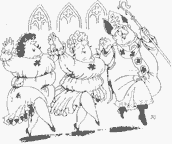 |
But the revolution has gone even further. Some bishops not only tolerate, approve, and promote such aberrations—they take part in them. The 28 February 1981 edition of The Catholic Herald Citizen in the Archdiocese of Milwaukee carried a report of what it described as a "Gospel Mass" which took place in St. John's Cathedral. "What," you may be asking, "is a 'Gospel Mass'?" That was the question I posed myself when I first read the report. Having done so I can tell you. It is, and I quote: "The kind of celebration that sends shivers down the arms and spine, that spurred both joyful handclapping and moistened eyes." The hands clapped and the eyes were moistened at the spectacle of what we in England would term a bevy of buxom wenches cavorting before the altar. The costumes they wore appeared designed to accentuate their more than ample proportions. But, and here we are coming down to what I believe is known in the U.S.A. as the "nitty-gritty," there were three bishops present. Three bishops of the holy Roman, Catholic and Apostolic Church, successors of the Apostles, men who not only possess the awesome power of bringing Christ down upon the altar but also have the power of creating new priests who can do so in their turn. Did these bishops rise up in protest? Did they take up their croziers and drive the buxom wenches from the sanctuary? No, they did not. One of them, Bishop James Lyke of Cleveland, Ohio, felt so shivery and tingly that he rose to his feet and joined in the hand-clapping!
"Gay Masses" in Seattle
Does this "Gospel Mass" in St. John's Cathedral represent the absolute nadir of liturgical profanity in the United States today? No, it does not! The emotions which the Milwaukee Gogo Girls may have aroused in the gentlemen present for the "Gospel Mass" may have been inappropriate for a Cathedral, but at least they were not perverted. But Archbishop Hunthausen of Seattle allows "Gay Masses" in his diocese. Surely this must be the absolute nadir. Men and women who publicly flaunt their addiction to a sin crying out to heaven for vengeance are recognized as a legitimate group within his diocese by a Catholic bishop, and allowed to use the Mass as a means to advertise their perversion and meet new partners.
Official and Unofficial
There are some conservative Catholics who would say that while the abuses I have mentioned are certainly outrageous they are unofficial. None of them were mandated by Vatican II. None of them are authorized by the Vatican. This is true. But can those who authorize, condone, or initiate a revolution disclaim all responsibility for the excesses of the revolutionaries? The abuses I have mentioned are horrifying, they are repellent. They have, I am sure, scandalized you all. Thank God that you have been scandalized. What is truly scandalous is that they would not outrage most Catholics in the U.S.A. today—that is what indicates the true extent and horror of the revolution, the turning upside down of what we knew before.
Before distinguishing between what is official and what is unofficial, I must make three other distinctions. We must consider firstly the Council, secondly the official conciliar reforms, and thirdly the unofficial abuses. What the liturgical bureaucrats, the commissars who are enforcing the liturgical revolution in your country and mine, have been successful in doing is to identify the post-conciliar reforms with the Council itself. Thus a complaint about any post-conciliar reform is equated as disobedience to the Council. I had often wondered what that mysterious sin against the Holy Ghost was, for which there is no forgiveness. I have discovered the answer and will share it with you. It is disobedience to the Council.
Disobedience to Vatican II
Thus, if a congregation objects to the removal of the tabernacle from the high altar, to be thrust into some obscure corner where it will not offend Protestant visitors who drop in for the occasional ecumenical sing-song, they will be told that they are "disobedient to the Council," when, in fact, there is not one word in any document of Vatican II which so much as hints that such an outrage should be perpetrated.
Time will permit me to discuss only the changes in the rite of Mass, not the changes in the entire complex of services which we describe as the Roman Rite. The Council Fathers ordered no more than a moderate revision of the rite of Mass, one which would have left it largely as it was before, and to which no reasonable person could have taken exception. Archbishop Dwyer of Portland admitted that when the Council Fathers voted for the Liturgy Constitution they had no idea of the manner in which it would actually be interpreted: "The thought of it would have horrified us," he remarked, "but it seemed so far beyond the realm of the possible as to be ridiculous. So we laughed it off."3 The good Archbishop had ceased laughing long before he died.
What, then, did the Liturgy Constitution actually order? We need to be clear about this if we are going to discuss disobedience to the Council. The Council ordered that "there must be no innovations unless the good of the Church genuinely and certainly requires them." Here is something I would like you to do. Take a Missal containing the Tridentine Mass. Read through the Order of Mass and compare it with the New Mass, the Novus Ordo Missae. Look at the innovations, examine carefully what has been removed, what has been added—then, at each change, ask yourself this question: "Did the good of the Church genuinely and certainly require this innovation?" Remember, we are considering at this moment one thing and one thing only—disobedience to the Council. I am not concerned here whether such and such an innovation was eventually made official by receiving Vatican approval. Let us fix our minds upon one point and one point only that the Council ordered that no innovations must be made unless the good of the Church genuinely and certainly requires them.
Let me put a few questions to you which might be helpful in the examination I had suggested. Read through the psalm Judica me at the beginning of the Mass. The psalm Judica me, those words mean something to every adult here. What memories they bring back, what associations they revive of piety and devotion. For many years I served the early morning Mass in my parish church. "Introibo ad altare Dei," said the priest. "Ad Deum qui laetificat juventutem meam," I answered, as servers were answering all over Britain, and would answer that day in countless
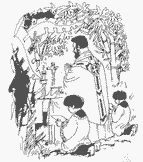 |
churches throughout the world as the sun rose, from the great Gothic cathedrals of Europe to the most humble mission station in the jungle of Burma; as servers had answered at the beginning of each new day throughout the centuries, long before Columbus discovered your country. "Introibo ad altare Dei," said the priest: "I will go to the altar of God." That was what being a priest was all about, that was what the Mass was all about, going to the altar of God each day to offer a solemn sacrifice for the living and for the dead, for himself and for his people. If you had asked a priest to define his vocation before the Second Vatican Council he would almost certainly have done so within the context of the Mass. On the day of his ordination the bishop had said to him: "Receive the power to offer sacrifice to God, and to celebrate Mass for the living and the dead in the name of the Lord." There is now a new rite of ordination which does not contain these words. And the priest no longer begins Mass by telling us that he is going to the altar of God, which is, perhaps, only fitting as usually all he will do is stand behind what the great Welsh martyr, St. Richard Gwynn, called in his own language, a "trestyl trist"—a "miserable table." I will return to the subject of this miserable table later, but for the moment I must try not to digress too far from the one point upon which I have asked you to fix your minds, the fact that the Second Vatican Council commanded that no innovations must be made unless genuinely and certainly required by the good of the Church.
Well, do you think that the good of the Church genuinely and certainly required that we should break with a tradition of a thousand years or more and cease beginning Mass with the beautiful psalm Judica me? Has it made Catholics today more devout than their parents were? Are their children more committed to the Faith than young Catholics were before the changes? I wonder, I just wonder. If you do not think that the good of the Church certainly required the abolition of this psalm then someone has been disobedient to the Council. Who is it? The Council ordered that any changes should express more clearly the holy things which the rite of Mass signifies. I cannot think of a single innovation, no, not one, that does this. The Mass is a sacrifice, a solemn and awesome sacrifice, one which should fill us with reverence, holy fear, and wonder. If anyone thinks that the innovations to which we have been subjected really make this more clear than the Old Mass did, then I would like them to explain just how.
|
In this restoration, both texts and rites should be drawn up so that they express more clearly the holy things which they signify.
Constitution on the Sacred Liturgy, Article 21
|
Let us call to mind briefly a few more of the innovations. Was that impressive double Confiteor which followed the Judica me a cause of spiritual 'atrophy'? Did kneeling at the Incarnatus est in the Creed harm the cause of doctrinal orthodoxy at a time when the dogma of the Incarnation is under attack from a resurgent and all pervasive Modernism? Were those sublime and specifically sacrificial Offertory prayers causing millions to lapse? Was the Last Gospel alienating youth? If you answer "no" to these questions you must ask yourselves, just who is disobedient to the Council?
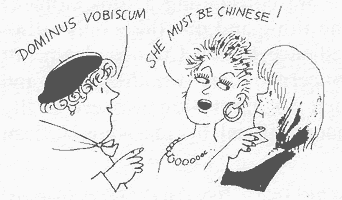 |
The Council ordered that Latin should remain the norm in the Latin Rite. Has it? Of course it hasn't! Who then is disobedient to the Council? The Council ordered that the treasury of sacred music is to be preserved and cultivated with great care. Well has it been? Of course it hasn't! Is much Palestrina, Monteverdi, Lassus, Schubert, or Mozart heard in the average parish church today? Of course it isn't! Do the words Panis Angelicus, Adoro te, Lauda Sion, Dies Irae, or Tantum ergo, or even Dominus vobiscum, mean anything at all to the children in your local Catholic high school? Of course they don't—if you doubt my word, go out and ask some of them. Look at the blank expressions you will see upon their faces, the bewilderment in their eyes. They would probably take a step away from you, afraid that you are some sort of kook using obscene words in a foreign language. It is these children who are the real victims of the revolution. You are all suffering from it, you feel deprived of the incomparable spiritual heritage of the Latin liturgy which you once knew, but at least you once knew it. You are unhappy because of what you have lost. The Catholic teenager today cannot regret what he has never known, but would you change places with him? Of course you wouldn't. These young people have been deprived of the birthright bequeathed to them not simply by immemorial tradition but by the Second Vatican Council itself. Who then is disobedient to the Council? I suggest that it is those who have defied the Council and deprived them of this birthright. I am sure that you will agree with me.
The Council ordered that Gregorian Chant should be given pride of place in liturgical services. Is it given pride of place in your parish, or the next parish, or the next parish to that? I doubt it. If it is, then your pastor is an heroic exception to the norm today. Thank God for him and pray that the good Lord will prolong his days. Search the documents of Vatican II as diligently as you can. I challenge anyone to find one word suggesting that altars should be replaced by tables, Mass said facing the people, Communion given in the hand, or that extraordinary ministers of Communion should be used. Bear this in mind when you hear your bishop fulminate about a priest who says the Tridentine Mass for a group of Catholics who have had as much of the liturgical revolution as they can take, and more, particularly when such a bishop allows the use of altar breads which are not of the traditional round host shape, as the Vatican demands they should be. Or, worst of all, allows altar breads to be made from material which makes them cake rather than bread, and means that the Masses in which they are used are invalid.4 And to cap it all, Mass stipends are taken from the faithful for such celebrations where, in fact, no Mass takes place! If we are going to talk about disobedience, let's set the question in its proper context.
|
The Church acknowledges Gregorian Chant as proper to the Roman liturgy: therefore, other things being equal, it should be given pride of place in liturgical services.
Constitution on the Sacred Liturgy, Article 116. |
Here's a particularly interesting instruction of the Council. Has this command been obeyed? See what you think.
In faithful obedience to tradition, the sacred Council declares that Holy Mother Church holds all lawfully recognized rites to be of equal right and dignity; that she wishes to preserve and foster them in every way.
Well, do you think that the Roman Rite has been preserved and fostered in every way? If you answer "No" then someone has definitely been disobedient to the Council. Let me quote a French priest, a man whose credentials would be considered as good as they possibly could be within the context of the Conciliar Church. I am talking about Father Joseph Gelineau, S.J. He was one of the experts who advised the Council Fathers on the liturgy. He remained in Rome to advise the committee which concocted the New Mass, and since its promulgation has been in the vanguard of the corps of liturgical commissars charged with its enforcement. Many of those in authority in the Church today claim that there is no significant difference between the Tridentine Mass and the New Mass. I hope that you learn more about British history in America than we in Britain learn about American history, and that you will therefore have heard about the Duke of Wellington who won the Battle of Waterloo. The Iron Duke, as he was called, was approached by a man one day who said, "Mr. Smith, I believe." "If you believe that," replied the Iron Duke, "you will believe anything." That is the reply that I would give to someone like the Canadian Cardinal, Emmet G. Carter, who claimed that there is virtually no difference at all between the two rites, and challenged anyone to debate him on the subject. I wrote him a very polite letter accepting his challenge, but he didn't reply. I have noticed that bad theology and bad manners often go together. But let us return to Father Gelineau. He is a different kettle of fish who, if I may mix my metaphors, does not beat about the bush but gets right down to the "nitty gritty." He makes no attempt to hide the true nature of the New Mass from us. I quote:
To tell the truth, it is a different liturgy of the Mass. This needs to be said without ambiguity: the Roman Rite as we knew it no longer exists. It has been destroyed.
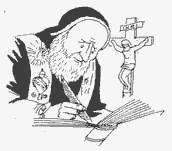 |
|
"By virtue of our Apostolic authority, We give and grant in perpetuity that for the singing or reading of Mass in any church whatsoever this Missal may be followed absolutely, without any scruple of conscience or fear of incurring any penalty."
|
The rite of Mass as you knew it until the post-conciliar revolution began in about 1965 was the culmination of a gradual and natural development under the influence of the Holy Ghost which lasted for fifteen hundred and seventy years. By the year of Our Lord 1570 it had reached as near perfection as anything upon this earth can ever be. Father Faber described it as "the most beautiful thing this side of heaven." In the year 1570, Pope St. Pius V codified the Roman Rite of Mass as it then existed, forever. No priest, he said, could ever be forced to say any other form of Mass. Vatican II ordered that all lawfully recognized rites should be preserved and fostered in every way. That is what the Council ordered. Father Gelineau boasts that the Roman Rite has been destroyed—and he ought to know. Is there anyone who would claim to be better qualified to interpret the true significance of the changes in the liturgy than Father Gelineau? I very much doubt it. Would anyone claim that you preserve and foster something by destroying it? I hope not. When we hear bishops and liturgical experts talking about disobedience to the Council, let us first consider those who have defied the Council and destroyed the most venerable rite in Christendom, probably the greatest treasure of our Christian faith after the Holy Scriptures, which were directly inspired by God Himself. I cannot understand how anyone of integrity can talk to us about a liturgical reform. There has been no reform. There has been a revolution, the Roman Rite has been destroyed. That's the truth, the plain unvarnished truth. There has been, as the Oxford Dictionary expressed it, "a complete change, a turning upside down, a great reversal of conditions, a fundamental reconstruction"—in other words, a revolution.
Some Expert Testimonies
Let me cite a few more authorities, and please note that not one of them is connected in any way with the traditionalist movement.
Father Louis Bouyer is another French priest. Like Father Gelineau he was very prominent in the liturgical movement. He is certainly one of the greatest living authorities on the liturgy. Father Bouyer was very enthusiastic about the Liturgy Constitution of the Second Vatican Council—so enthusiastic that he wrote a book about it, one of the many fine scholarly works which have come from his pen. He called it The Liturgy Revived. Its title makes the theme clear. There was to be a great revival in the liturgy, a great renewal, and this renewal would revitalize the life of the entire Church, at least where the Roman Rite was concerned. But like Father Gelineau, Father Bouyer is an honest man. Unlike Father Gelineau, he deplores what has been foisted upon us in the name of the Council. He has now written another book. It is entitled The Decomposition of Catholicism. Once again, the theme is made clear by the title. In this book Father Bouyer admits that far from the hoped-for renewal following the Council what we are witnessing is the accelerated decomposition of Catholicism, that the liturgical changes are a betrayal of the Liturgy Constitution, the will of the Council Fathers and the entire papally-approved liturgical movement. He even claims that there is no liturgy worthy of the name in the Church today.5 Strong words, but if anyone knows what he is talking about, Father Bouyer does.
One of the best books written concerning the changes in the Mass is The Recovery of the Sacred by Professor James Hitchcock. Professor Hitchcock is a conservative, not a traditionalist. Perhaps I better clarify the difference. A conservative Catholic is one who accepts all the defined doctrinal and moral teaching of the Church without question. He probably dislikes the liturgical changes which have followed the Council, but once they have been approved by the Pope, he feels that it is his duty to accept them whatever his personal feelings. This is a perfectly credible position, for which a strong case can be made and one which I respect. The defined doctrinal and moral teaching of the Church which every Catholic is bound to accept is known as Tradition, with a capital "T". Throughout the centuries this Tradition has come to be expressed by many traditions, with a small "t". We must believe that Our Lord instituted the priesthood: that is part of Tradition. Hans Küng denies this, therefore he is a heretic. It is a tradition within the Roman Rite that priests remain celibate: this is a tradition, a matter of discipline, and could be changed. The traditional liturgy incorporates countless traditions, with a small "t", all of which reflect what Catholic Tradition with a capital "T" requires us to believe about the Holy Sacrifice of the Mass. At no time in the history of the Church has there been a radical reform of the liturgy such as that following Vatican II. It was completely unprecedented. Such a radical reform is in itself a breach of Tradition. A traditionalist Catholic is one who considers that the wholesale abolition of liturgical traditions, with a small "t", can weaken belief in Tradition itself. He therefore works for the restoration of abandoned traditions, or in some cases refuses to accept what has replaced them. This is also a credible position for which a case can be made. Referring to changes in religious ceremonies, Cardinal Newman warned that: "Although these forms are not directly from God, long use has made them divine for us, and to destroy them is to unsettle and dislodge the religious principle itself for most people." The Cardinal warned that: "We should be on our guard against those who hope that by inducing us to lay aside our forms, at length to make us lay aside our Christian hope altogether." Like anything Newman wrote, these words merit careful consideration. But, as I have said, Professor Hitchcock is a conservative Catholic. He does not approve of traditionalists and tells us this with a frequency that is somewhat tedious. However, in the book which I have mentioned, he has a chapter entitled "The Liturgical Revolution," and comments upon the remarkable speed with which it occurred.
We should be on our guard against those who hope that by inducing us to lay aside our forms, at length to make us lay aside our Christian hope altogether.—Cardinal Newman
Father Kenneth Baker, S.J., is Editor of the Homiletic and Pastoral Review, the most widely read journal for priests in the English-speaking world. It is a conservative, not a traditionalist publication. In his February 1979 edition, Father Baker deplored the liturgical upheavals that we have been through during the past fifteen years and put a very pertinent question to the hierarchy: "I ask, is it not time to stop the liturgical revolution?" I could cite many similar testimonies, but I will content myself with only two more. There are many others in Chapter III of my book, Pope Paul's New Mass.
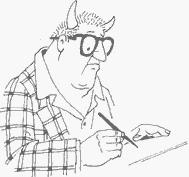 |
There are two categories of people whose views are listened to with the greatest respect by Catholic bishops today; these are Protestants and sociologists. Well, here is the testimony of a man who is a Protestant and a sociologist. Professor Peter L. Berger is a Lutheran professor of sociology, and in a lecture delivered at the Harvard Club in New York on 11 May 1978 he commented upon the changes in our liturgy from the dispassionate standpoint of a professional sociologist. He insists that we must speak of "the liturgical revolution—no other term will do." He continues: "If a thoroughly malicious sociologist, bent on injuring the Catholic community as much as possible, had been an adviser to the Church, he could hardly have done a better job."6 That's pitching it pretty strongly, isn't it?
Now, note very carefully my final quote upon this particular subject. The man who made it was a Catholic, so his opinion won't carry quite the same weight as that of Professor Berger. And he wasn't a sociologist, simply one of the most brilliant Catholic theologians and philosophers living in your country in this century. I refer to Professor Dietrich von Hildebrand who stated that: "Truly, if one of the devils in C. S. Lewis's The Screwtape Letters had been entrusted with the ruin of the liturgy, he could not have done it better."
"In faithful obedience to tradition, this most sacred Council declares that Holy Mother Church holds all lawfully acknowledged rites to be of equal authority and dignity; that she wishes to preserve them in the future and to foster them in every way."
Constitution on the Sacred Liturgy, Article 4
The Power of the Periti
Am I attempting to exculpate the Council from all responsibility? Definitely not! What, then, went wrong? Two things, but two things that are very closely connected. Briefly, this is what happened. The documents of Vatican II were drafted not by the bishops themselves but by the experts they brought with them, the notorious periti. Peritus is a Latin term meaning "expert adviser." Many of these experts were men of advanced views, or, to put it bluntly, crypto-modernists. Since the Council some have come out into the open and are quite clearly not Catholics: Hans Küng, Gregory Baum, and Edward Schillebeeckx provide typical examples. Bishop Lucey of Cork and Ross, Ireland, one of the Council Fathers, admitted that the experts were the people with real power. Cardinal Heenan of England was acutely aware of this danger. He warned that phrases were being inserted into the documents capable of both an orthodox and modernist interpretation. "I fear the periti," he said. God forbid, he added, that they should be allowed to interpret the mind of the Council to the world. But this is precisely what happened. When the Council was over committees were set up to interpret its various documents. These committees were chosen largely from the ranks of the periti.7 Thus the very men who had inserted ambiguous texts into the Council documents were given the power to interpret these key passages after the Council in precisely the manner they had intended to interpret them. All this is fully documented in my book, Pope John's Council.
I am going to cite Cardinal Heenan again. This is an important quotation, which summarizes accurately what I have been trying to put over to you. Cardinal Heenan was the Primate of the Catholic Church in England and Wales, a good scholar, and one of the most active Fathers during the Second Vatican Council. He knew what he was talking about. Here is what he had to say concerning the debate on the Liturgy Constitution:
It might be more accurate to say that the bishops were under the impression that the liturgy had been fully discussed. In retrospect it is clear that they were given the opportunity of discussing only general principles. Subsequent changes were more radical than those intended by Pope John and the bishops who passed the decree on the liturgy. His sermon at the end of the first session shows that Pope John did not suspect what was being planned by the liturgical experts.
The Consilium
Well, that's clear enough isn't it? Cardinal Heenan states quite explicitly that the liturgical experts who drafted the Constitution on the Liturgy planned to use it in a way that Pope John XXIII did not suspect. And these same men were later chosen to join the Commission, the notorious Consilium, which concocted the New Mass. I would like to quote another Council Father on the subject of this Consilium, Archbishop Dwyer once again: "The great mistake of the Council Fathers," he wrote, "was to allow the implementation of the Constitution on the Sacred Liturgy to fall into the hands of men who were either unscrupulous or incompetent. This is the so-called 'Liturgical Establishment,' a Sacred Cow which acts more like a White Elephant as it tramples the shards of a shattered liturgy with ponderous abandon."8
Archbishop Dwyer considered that the men who implemented the Liturgy Constitution were either unscrupulous or incompetent. My own research reveals that they were extremely competent in achieving their objectives. We must therefore conclude that they were unscrupulous. The Consilium had a number of titular heads, but it had a permanent secretary, Archbishop Annibale Bugnini, who died in July this year. May God have mercy upon his soul, and may God forgive him for the havoc he wrought within the liturgy of the Roman Rite. He was described by Professor von Hildebrand as "the evil spirit of the liturgical reform."9 His story is told in great detail in my book, Pope Paul's New Mass, and I won't repeat it here. I will simply mention that he was secretary of the pre-conciliar commission which drafted the Liturgy Constitution; historians of the period tend to refer to it as "the Bugnini draft." He was then dismissed by Pope John XXIII, the reason has never been divulged, but it must have been very serious for the Pope to take such drastic action. Incredibly, Pope Paul VI re-appointed him as Secretary of the post-conciliar Consilium which was to implement the Constitution which he had drafted, and which had passed virtually unchanged.
|
"There must be no innovations unless the good of the Church genuinely and certainly requires them; and care must be taken that any new forms adopted should in some way grow organically from forms already existing." Constitution on the Sacred Liturgy, Article 23 |
Six Protestant Observers were invited to advise this Consilium. They played an active part in the preparation of the New Mass. This was publicly denied by Archbishop Bugnini, and he certainly knew that he was making a totally false statement.10 Even if the participation of the Protestant Observers in the concoction of the New Mass had not become generally known it would have been possible to deduce their presence from the changes that were made. Almost all the official reforms tend in a Protestant direction. I do not intend to attempt to prove this to you now. It is a fact that is so obvious that those of you who follow up my suggestion of examining the Order of Mass in your old Missals, and studying the manner in which it has been changed, can only come to the same conclusion that I have reached.
The Ottaviani Intervention
Some of you will have heard of a critique of the New Mass written by a group of Roman theologians and forwarded to the Pope with a covering letter by Cardinals Ottaviani and Bacci.11 At least a dozen cardinals had intended signing this letter, but it was leaked and published prematurely. All the cardinals but the two I have mentioned "chickened out." Please bear in mind that Cardinal Ottaviani was, at the time, Prefect of the Holy Office, charged with maintaining the purity of the faith. His verdict on the New Mass is thus of particular significance.
Here is the conclusion which he and Cardinal Bacci sent to the Pope:
The Novus Ordo Missae—considering the new elements, susceptible of widely differing evaluations, which appear to be implied or taken for granted —represents, as a whole or in detail, a striking departure from the Catholic theology of the Holy Mass as it was formulated in Session XXII of the Council of Trent, which, by fixing definitively the 'canons' of the rite, erected an insuperable barrier against any heresy which might attack the integrity of the Mystery.
These are very strong words, but please don't accuse me of disloyalty to the Church for citing them. If you feel you must accuse someone, then accuse the Cardinals concerned.
Exit Archbishop Bugnini
As for Archbishop Bugnini, in 1975 he fell suddenly and dramatically from power. Pope Paul VI dismissed him without any reason being given, just as Pope John had done, and he was banished to Iran as Pro Nuncio. His admirers throughout the world were outraged, and feared that the entire future of the liturgical revolution was in danger. Their fears were groundless. In the year before his downfall he had been able to announce with pride and satisfaction that the liturgical reform was "a major conquest of the Catholic Church" which had its "ecumenical dimensions."12 I wouldn't want to quarrel with that judgment. There are grounds for believing that Archbishop Bugnini was dismissed by Pope Paul VI after the Pope had been given evidence proving that he was a Freemason. I have published the evidence for this allegation in my book, Pope Paul's New Mass.13 Archbishop Bugnini termed me a "calumniator" for doing so, and denied the accusation. In some ways I am sorry that the issue was ever raised as it makes the important question appear to be whether the Archbishop was a Mason or not. The important question is whether or not he destroyed the liturgy of the Roman Rite rather than his motive for doing so. Even if he was motivated by a sincere desire to serve the Church it does not alter the fact that, as Professor Berger expressed it, "a thoroughly malicious sociologist, bent on injuring the Catholic community as much as possible...could hardly have done a better job."
Protestant Parallels
I could go into very great detail to prove that most of the changes which have received official approval tend in a Protestant direction. If challenged I would be happy to do so. For the moment just let me say that almost every prayer which the Protestant Reformers removed from the traditional Mass has been removed during the liturgical revolution. The one notable exception is the Roman Canon, which the Consilium wished to remove, but which was retained on the personal insistence of Pope Paul VI himself. I would like to make it clear that I have never alleged that the New Mass is Protestant. What I have claimed is that there are parallels between the changes the Protestant Reformers made in the traditional Mass, and those made by Archbishop Bugnini and his Protestant advisers, or admitted as options at a later date.
|
"Steps should be taken so that the faithful may also be able to say or sing together in Latin those parts of the Ordinary of the Mass which pertain to them."
|
Let me give just three examples. One of the first steps taken by all the Protestant Reformers was to abolish the traditional Offertory prayers because, as Luther expressed it in his usual charming way, "they stank of sacrifice." They have been abolished in the New Mass. Communion in the hand is now permitted as an official option. It was a widespread practice in the early Church but lapsed as reverence for and devotion to the Blessed Sacrament increased. It was revived by the Protestant Reformers to signify two things; firstly, that the bread received in Communion is ordinary bread, secondly, that the minister who distributes it is an ordinary man who possesses no powers which are not possessed by his congregation. If he alone has the authority to touch the Sacrament, then it could give the impression that he alone has the power to consecrate. The fact that the priest alone does have the power to consecrate was one of the reasons given by St. Thomas Aquinas in his explanation of why the priest alone should touch the Host. The teaching of St. Thomas was echoed recently by Pope John Paul II who has made it clear that he gives his personal endorsement to the traditional practice, even if he feels that it would be futile to attempt to re-impose it during the present climate.14
A Miserable Table
The final example I will give of a change not sanctioned by the Council, but now almost universal, is one I mentioned earlier—that of the replacement of the altar by a "miserable table," and the celebration of Mass facing the people. We are told that this is the restoration of an ancient custom of the Church. This is nonsense. It has always been the tradition of the Church that Mass should be celebrated facing the East, which is a symbol of the Resurrection. The sun rises in the East each day just as the Son of God rose from the dead.15
What about the Last Supper? This is a question often put to traditionalists by self-styled liturgical experts whose knowledge of liturgical history seems to be as nonexistent as my own understanding of the complex rules of American football. They tell us that at the Last Supper Our Lord did not turn His back upon the people. What a silly thing to say. At the Last Supper Our Lord most certainly did not face His Apostles across a table. They were all on the same side, facing Jerusalem, as the Jews still do when they pray. Another reason Christians faced the East when they prayed was to emphasize the break with Judaism. The Jews faced Jerusalem when they worshipped, Christians faced the East—symbol of the heavenly Jerusalem. Once again, it was the Protestant Reformers who rejected this tradition due to its sacrificial connotation, and began the practice of the minister facing his congregation across a table. I use the word table deliberately. Nicholas Ridley, the Protestant Bishop of London, wrote in 1550: "The form of a table shall more move the simple from the superstitious opinions of the popish Mass unto the right use of the Lord's Supper. For the use of an altar is to make sacrifice upon it: the use of a table is to serve for men to eat upon."
Pope Pius XII Speaks Out
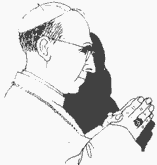 |
Now here's an interesting point. In his Encyclical Mediator Dei, Pope Pius XII warned of "a wicked movement that tends to paralyze the sanctifying and salutary action by which the liturgy leads the children of adoption on the path to their heavenly Father." This wicked movement was concerned with reviving obsolete liturgical practices on the grounds that they were more primitive, and one of the suggestions Pope Pius condemned it for advocating was the restoration of the altar to the form of a table.
What I find interesting, perhaps "disturbing" would be a better word, is how something condemned by a Pope as "wicked" in 1947 suddenly becomes admirable in 1982. Similarly, Pope Pius condemned the suggestion that the tabernacle should be removed from the altar as "a lessening of esteem for the presence and action of Christ in the tabernacle. To separate altar and tabernacle," he wrote," is to separate two things which by their origin and their nature should remain united." That's interesting, isn't it? How many churches do you know where Mass is still celebrated on an altar with a tabernacle?
The International Commission on English in the Liturgy
I would like to talk to you about the translation of Pope Paul's New Mass made by the ICEL—the International Commission on English in the Liturgy. The Mass which Cardinals Ottaviani and Bacci criticized so severely was the official Latin version approved by the Pope. But what you have in America and what we have in England, is not even this Mass. The papally-approved Novus Ordo has been so mutilated in translation that it is reasonable to describe the ICEL version as an entirely different rite of Mass. What remained of the doctrine of sacrifice in the Latin version of the Novus Ordo has been systematically removed or diluted in the ICEL version. And the standard of its English is as poor as the standard of its theology. See what you think of this comment: the ICEL translation of the Mass is "inept, puerile, semi-literate," it has "done immeasurable harm to the entire English-speaking world," it is marked by "an almost complete lack of literary sense, a crass insensitivity to the poetry of language, and, even worse, by a most unscholarly freedom in the rendering of the texts, amounting at times to actual misrepresentation." "Actual misrepresentation"—that's a very strong accusation and can you guess who made it? Archbishop Dwyer of Portland, Oregon. And it is this "inept, puerile, semi-literate" translation "amounting at times to actual misrepresentation" to which almost all English-speaking Catholics are subjected each Sunday. Is it any wonder that their faith is being undermined?
Father Frechette Objects
"Well, all right," I can imagine some intrepid supporter of the revolution saying—it might well be Father Frechette of Baltimore: let's picture him sitting on the trunk in which he conceals visiting priests before they leap out to celebrate Mass, preside over the family meal, or do whatever it is they believe they do when they stand behind the table. He pats his little dog on the head. "Well, all right, let's concede that you are right," he says, "let's concede that there has been a revolution rather than a reform, that most of the changes were not mandated by Vatican II, that some even contradict its teaching, that many Protestant practices—I would rather call them 'insights'—have been incorporated into our liturgy, that the English we use is not quite what Shakespeare would have written (but who reads Shakespeare today, anyway?), all this may be true—but look at the great pastoral benefits which the reform has brought. Surely that is what really matters. The people can understand the Mass now, they can play an active part, they enjoy coming to church. When we consider this, all the objections you have been making are mere pedantry. You people are no better than modern-day Pharisees." He pats his little dog on the head once more, and smiles at us complacently.
"By Their Fruits Ye Shall Know Them"
My answer to this viewpoint, which I have often heard expressed, is that the liturgical reform has brought no pastoral benefits at all. If, as we are assured, the traditional Latin Mass was an obstacle to understanding and participation, then the first and most obvious fruit of the revolution would have been a dramatic increase in Mass attendance. In no country can any evidence be produced of such an increase. In most western countries there has been a decline which can be described justly as catastrophic: declines of over 60% in France and Holland, 50% in Italy, 30% in the U.S.A., 20% in Great Britain. What these figures mean is that tens of millions, I repeat, tens of millions of men and women who went to Mass in the bad old days when the liturgy was supposed to have alienated them from the Church have ceased to attend now. And yet according to the "experts" it has been a great pastoral success and we are deliriously happy with it. I don't know about you, but I'm not deliriously happy. Listen to Archbishop Bugnini for the very last time: "The renewed Mass was received with joy, with enthusiasm, and in a short time entered into the practice of the Christian people, with obvious advantages to the community.'' Well, if I may quote the Duke of Wellington again: "If you believe that, you'll believe anything."
|
"Particular law remaining in force, the use of the Latin language is to be preserved in the Latin rites." Constitution on the Sacred Liturgy, Article 36 |
Now, these liturgical experts are very strange people. They keep telling us that the revolution has been a tremendous pastoral success, and when we prove to them that it has not been, they reply that the undeniable decline in Mass attendance can't be attributed to the post-conciliar changes. Can't it indeed! They repeat an old adage with which you are probably familiar, post hoc non ergo propter hoc, which I will translate as "afterwards, but not necessarily because of." Because the decline followed the reform it does not necessarily follow that it was because of the reform. Well, suppose in your country the reform had been followed by a 30% increase in Mass attendance, and some reactionary Catholic who preferred Latin said that it could not be proved that this had anything to do with the changes, would the liturgical "experts" have taken him seriously? Of course they wouldn't. Nor do I take them seriously when they argue that the current decline has nothing to do with their revolution. I am not arguing that the liturgical revolution is the only cause of the decline. The principal reason is a triumphant resurgence of the Modernism condemned by Pope St. Pius X. The liturgical revolution is an effect, not the cause of this resurgent Modernism, but it is through the liturgical revolution that the lives of ordinary Catholics have been most immediately affected. The way they now worship reflects what they now believe—lex orandi, lex credendi.
The Pope Apologizes
In his Apostolic Letter Dominicae Cenae, published in 1980, Pope John Paul II made one of the most extraordinary statements ever to come from a successor of St. Peter. It was an apology, an apology to all of us, made in his own name and that of his brother bishops—though I have yet to hear one of them endorse it in his personal capacity. Here are the Pope's words:
I would like to ask forgiveness—in my own name and in the name of all of you, venerable and dear brothers in the Episcopate—for everything which, for whatever reason, through whatever human weakness, impatience or negligence, and also through the at times partial, one-sided and erroneous application of the directives of the Second Vatican Council, may have caused scandal and disturbance concerning the interpretation of the doctrine and the veneration due to this great Sacrament.
I am sure that we are all grateful to the Holy Father for making this statement, we admire the courage and humility which he has shown in doing so. But if I had the chance to speak to him, I would say: "Most Holy Father, I thank you for your compassion, I thank you for your apology, but Holy Father, this is not enough. What the faithful need from you, what we beg from you upon our knees is some action. Since you made your apology in 1980, the situation has worsened, and it continues to worsen almost daily."
And speaking on my own behalf, the action I would ask for would not be just the correction of abuses, not just a better translation of the New Mass, but the restoration of the complete and unabridged Tridentine Mass, "the most beautiful thing this side of heaven," the greatest treasure of the Western Church.
Some Conclusions
I will now sum up very briefly what I have tried to convey to you:
1) Since the Second Vatican Council there has been a revolution rather than a reform within the liturgy of the Roman Rite.
2) Even the officially approved changes were far more radical than Pope John XXIII and the Council Fathers had intended.
3) Few of these official changes were actually mandated by the Council.
4) There have been countless unofficial abuses such as dancing in the sanctuary which bishops have condoned and sometimes actively support.
5) Some of the officially approved changes break with the consistent liturgical tradition of the Roman Rite, and contradict the clear teaching of Roman Pontiffs.
6) Protestant Observers played an active part in concocting the New Mass, which incorporates many disturbing ecumenical concessions even in the papally-approved Latin version.
7) The ICEL version of the Mass contains so many serious linguistic and doctrinal deficiencies that it is legitimate to complain that it is not the rite of Mass approved by Rome.
8) The Revolution has been a pastoral fiasco which has produced no good fruits.
9) The Roman Rite has been destroyed.
I will conclude my talk by quoting just one sentence written by Archbishop Lefebvre. It sums up exactly what I have been saying to you tonight. "All these changes," he wrote in 1974, "have but one justification; an aberrant senseless ecumenism that will not attract a single Protestant to the Faith, but will cause countless Catholics to lose it, and will instill total confusion in the minds of many more who will no longer know what is true and what is false."
Reverend Fathers, ladies and gentlemen, if you will have the fairness to consider this sentence very carefully, if you will look around you at the liturgical situation in your own country with complete objectivity, if you examine your old missals as I have suggested and note for yourselves the changes that have been made, do you know, I have a feeling that some of you just might agree with him.
1. This Prayer Book of 1549 was as clear a sign as a man might desire that a doctrinal revolution was intended and that it was, indeed alreaday in progress. Once these new sacramental rites, for example, had become the habit of the English people the substance of the doctrinal reformation, victorious now in northern Europe would have transformed England also. All but insensibly, as the years went by, the beliefs enshrined in the old and now disused rites, and kept alive by these rites in men's minds and affections, would disappear—without the need of any systematic missionary effort to preach them down. And pending the arrival of the day when such missionaries could be found, and trained to preach the meaning of the new, these rites newly devised would dispose the minds of those who used them, forming habits of piety for which only the new theologies could give a congenial explanation. Msgr. Philip Hughes, The Reformation in England (London, 1953), vol. II, p. 111.
2. Archbishop Dwyer's undelivered letter was published in Orthodoxy of Catholic Doctrine, January, 1977.
3. Michael Davies, Pope John's Council (Angelus Press), p. 224.
4. Michael Davies, Pope Paul's New Mass (Angelus Press), Appendix VI. This Appendix gives the full text of a Vatican directive, approved by Pope John Paul II on 11 May 1979, ordering the American bishops to ensure that only valid matter was used for the Holy Eucharist. The October 1982 issue of the Homiletic and Pastoral Review reports that invalid matter was still being used in at least three different states (p. 71.)
5. Pope Paul's New Mass, p. 78.
6. Pope Paul's New Mass, p. 80.
7. Pope John's Council, p. 42.
8. Pope John's Council, p. 226.
9. Pope Paul's New Mass, p. 65.
10. Pope Paul's New Mass, Appendix III.
11. Ibid. Chapter XXIII.
12. Pope Paul's New Mass, p. 81.
13. Pope Paul's New Mass, Chapter XXIV.
14. See "A Privilege of the Ordained," (Angelus Press).
15. Pope Paul's New Mass, Chapter XIX.
